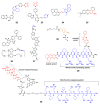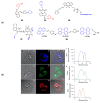Recent Advances in Organelle-Targeted Fluorescent Probes
- PMID: 33406634
- PMCID: PMC7795030
- DOI: 10.3390/molecules26010217
Recent Advances in Organelle-Targeted Fluorescent Probes
Abstract
Recent advances in fluorescence imaging techniques and super-resolution microscopy have extended the applications of fluorescent probes in studying various cellular processes at the molecular level. Specifically, organelle-targeted probes have been commonly used to detect cellular metabolites and transient chemical messengers with high precision and have become invaluable tools to study biochemical pathways. Moreover, several recent studies reported various labeling strategies and novel chemical scaffolds to enhance target specificity and responsiveness. In this review, we will survey the most recent reports of organelle-targeted fluorescent probes and assess their general strategies and structural features on the basis of their target organelles. We will discuss the advantages of the currently used probes and the potential challenges in their application as well as future directions.
Keywords: chemical probes; fluorescence imaging; organelle-targeting.
Conflict of interest statement
The authors declare no conflict of interest.
Figures









References
Publication types
MeSH terms
Substances
Grants and funding
LinkOut - more resources
Full Text Sources
Other Literature Sources

